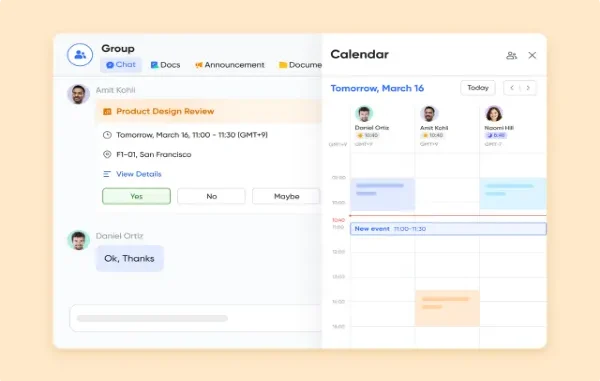
Meetings are one of the costliest investments that businesses undertake. The time in meeting rooms or on video calls is time that is taken away from execution and we know that the quality of meeting makes the difference between making you more effective and choking the momentum of your work. Too often, meetings are conducted without structure, outcomes or accountability causing laziness for the employees, and disengagement from the employees.
Organizations can develop a meeting culture by ensuring that the tools that they use connect scheduling, conversation, and follow up into one frictionless experience. Therefore newer project management tools are geared towards making meetings engines for clarity and action.
Lark Calendar: creating structure before meetings begin
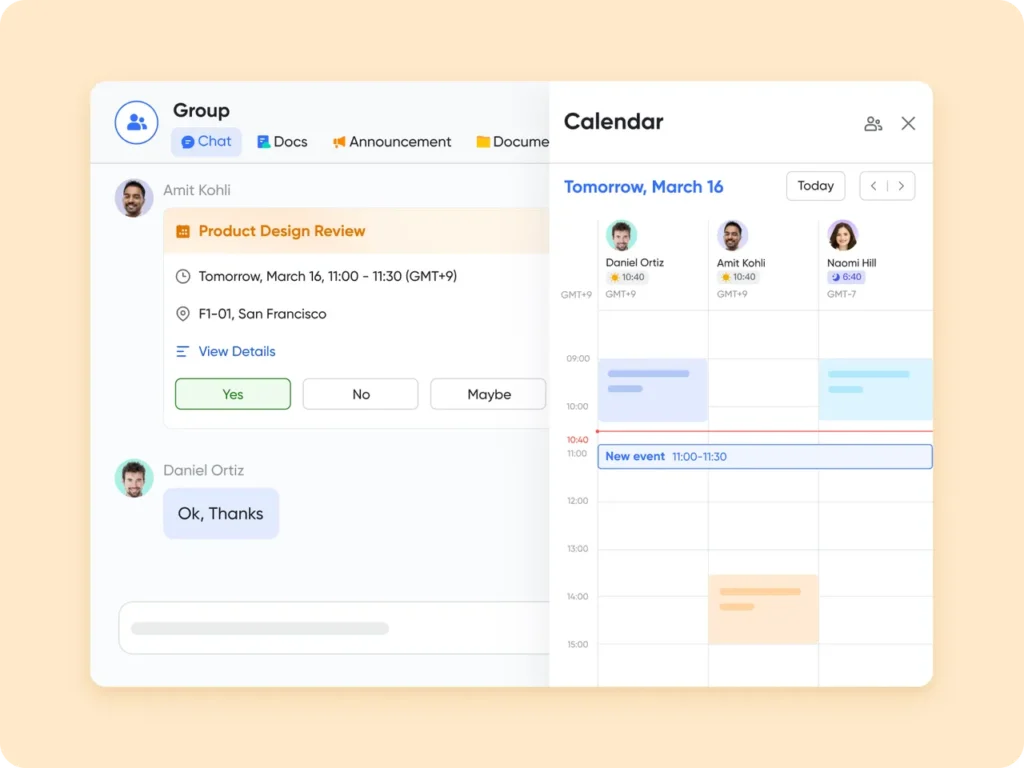
Efficient meetings start with smart planning. Lark Calendar helps you sort out the mess of finding the best time, getting the correct people involved, and making sure everyone’s set to share ideas. It does more than put meetings on the calendar—it sets the stage for meetings where things actually get done.
- Shared Visibility: Calendar shows team availability across regions, helping leaders avoid conflicts and reducing last-minute rescheduling. This ensures that meetings start with the right people in the room, rather than wasting time coordinating.
- Smart Reminders: Automated reminders notify participants ahead of time, giving them space to prepare materials and align on discussion points before the call. This preparation step reduces wasted time during the meeting itself.
- Contextual Links: Calendar events can include relevant documents, agendas, or Base records, ensuring participants enter meetings informed. Attendees don’t waste valuable minutes searching for files.
- Recurring Rhythms: Leaders can establish regular check-ins or planning sessions, giving teams a predictable rhythm and reducing the need for unnecessary ad-hoc meetings.
- Time-Zone Awareness: Built-in adjustments ensure global teams schedule efficiently, reducing fatigue and confusion from poorly timed meetings.
Lark Meetings: making every session purposeful
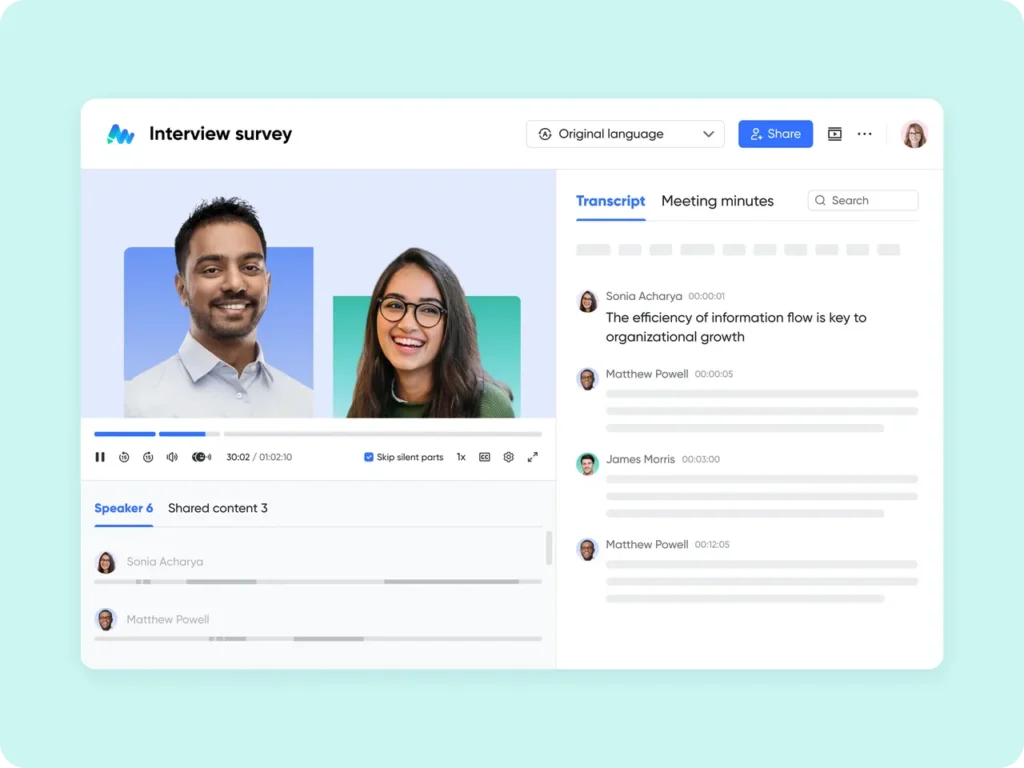
Once people gather, the challenge becomes keeping discussions focused and outcomes clear. Lark Meetings enhances collaboration by making virtual sessions dynamic, accessible, and tightly connected to the rest of the workflow.
- One-Click Access: Employees can join directly from Calendar or Messenger, eliminating wasted time hunting for links and ensuring punctual starts.
- Screen Sharing and Collaboration Tools: Presenters share visuals or data while teams interact in real time, creating shared understanding instead of one-sided updates.
- Live Captions: Teams improve accessibility, ensuring participants follow discussions clearly regardless of language or audio quality.
- Meeting Recordings: Sessions are captured securely for employees who cannot attend, reducing the pressure of over-scheduling everyone into every meeting.
- Interactive Engagement: Features like chat and reactions keep participants involved, making meetings more collaborative and less passive.
Lark Minutes: capturing outcomes without extra effort
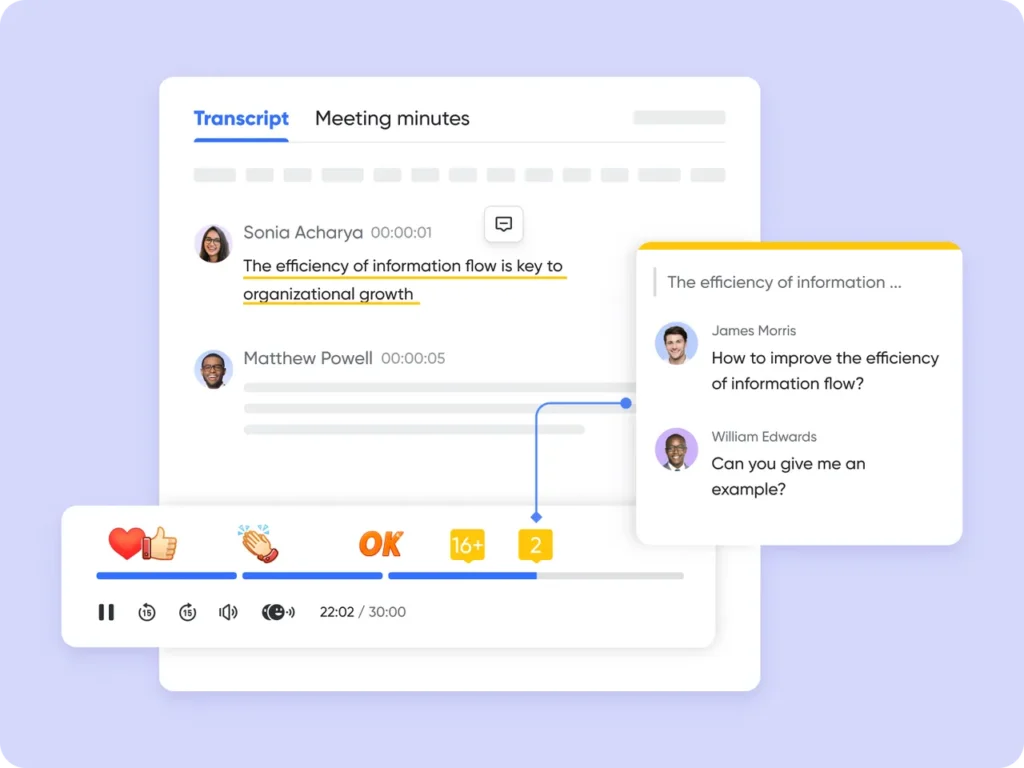
One of the biggest reasons meeting fatigue sets in is the lack of clarity afterward. Lark Minutes transforms discussions into actionable resources by recording, summarizing, and distributing outcomes automatically.
- Automatic Transcription: Conversations are captured word-for-word, reducing the need for manual note-taking and ensuring accuracy. This frees participants to stay engaged.
- Clip Sharing: Teams distribute only the relevant sections of meetings, saving time and allowing employees to focus on what matters most to them.
- Searchable Archives: Past meetings become resources, helping teams revisit decisions and maintain continuity without repeating discussions.
Lark Base: linking meeting insights with broader execution
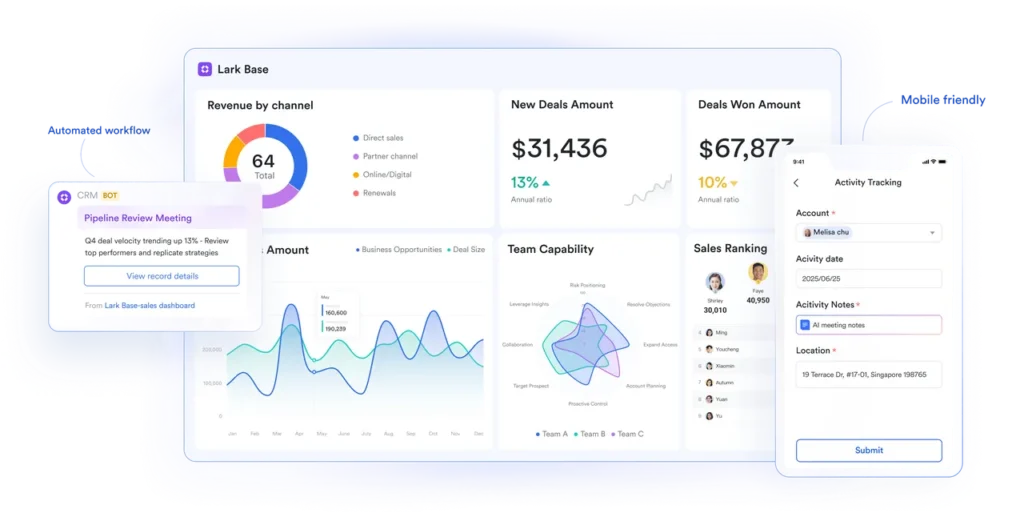
Meetings often lead to ideas and resolutions, yet if there’s no process to record them, they may become lost forever. Lark Base offers a structured environment to help yield outcomes from discussions into ongoing execution.
- Structured Databases: Teams log meeting outcomes directly in Base, ensuring responsibilities, deadlines, and ownership are clearly defined.
- Dashboards: Leaders gain visibility into how meeting-driven decisions connect with broader company projects, creating alignment across departments.
- Automations: Updates triggered by meeting outcomes happen automatically, so progress doesn’t depend on manual follow-ups.
- Dependencies Tracking: Base reveals how actions from one meeting affect other projects, preventing misalignment.
- Customer-to-Project Linkages: Meeting outcomes tied to client needs are logged alongside customer data, allowing Base to support CRM app processes that keep customer priorities connected to project execution.
Lark Approval: streamlining decisions during and after meetings
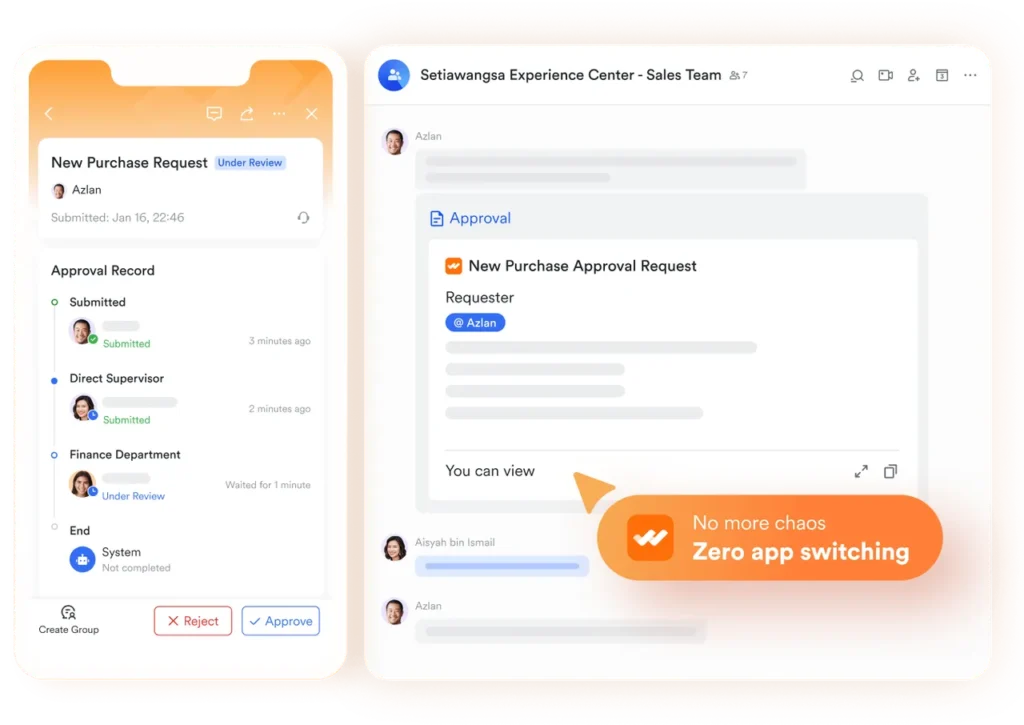
Slow decisions can mess up even the best talks. Lark Approval makes sure approvals and requests get where they need to go, get tracked, and get done fast. It turns talk into real action.
- Custom Forms: Teams submit structured requests during or after meetings, ensuring leaders have the context they need to approve decisions.
- Automated Routing: Requests move to the right stakeholders without manual effort, reducing delays and confusion. By working inside an automated workflow, approvals become predictable.
- Messenger Notifications: Approvers receive reminders where they already collaborate, reducing the need for extra meetings to follow up.
- Approval Logs: Every decision is recorded, providing transparency and accountability for meeting-driven outcomes.
- Performance Insights: Leaders review turnaround times and identify bottlenecks, ensuring decision-making stays aligned with company priorities.
Lark Docs: building shared context before and after meetings
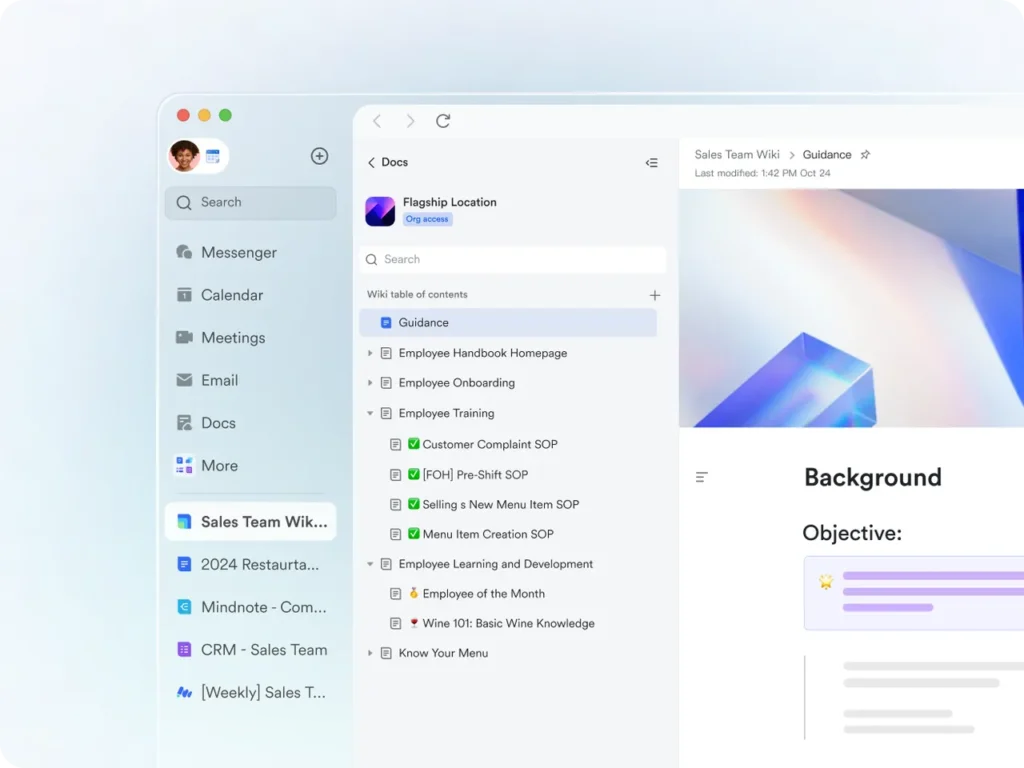
Preparation and follow-up can make or break meeting culture. Lark Docs supports both by providing a collaborative space where agendas, proposals, and outcomes remain visible and actionable.
- Co-Editing: Teams build agendas collaboratively, ensuring everyone arrives aligned and ready to contribute.
- Embedded Data: Sheets and dashboards can be included directly in Docs, so discussions are grounded in live, accurate data.
- Inline Comments: Feedback happens within the context of documents, clarifying misunderstandings before they spill into meeting time.
- Version History: Teams track how ideas evolve across discussions, preventing confusion and avoiding redundant meetings.
- Task Connections: Docs link directly to tasks or approvals, so agreements written down are immediately tied to execution.
Conclusion
Changing meeting culture involves not oding on meetings; it’s about making each meeting meaningful. Lark delivers the capabilities to connect scheduling to collaboration to follow-up in one continuous stream. Lark Calendar provides structure before meetings, Lark Meetings makes interactions productive and focused, Lark Minutes records outcomes, Lark Base connected conversations back to overall projects, Lark Approval speeds up decisions, and Docs consistently maintains workflow.
With all of these capabilities, organizations can create a culture where meetings are no longer sources of exhaustion but sources of momentum. Each meeting drives execution, every decision is recorded, and every employee emerges with clarity. That’s a cultural change: changing meeting from sources of distraction or drift to sources of action.






Leave a Reply